Ravnica Allegiance will be coming soon, and spoilers have already begun. Like all sets based on Ravnica, a suite of guild mechanics define the Limited environment. This time around, we get an expected mix of aggressive (Gruul), defensive (Orzhov), and nonsense (Simic) archetypes, along with the destructive (Rakdos) and disruptive (Azorius). Each has a unique new mechanic that will define how the guild plays in matches of Limited. For the most part, at least.
We haven’t seen too many cards yet, so it’s hard to get a full picture of what each mechanic does. There’s room to speculate, however, and each mechanic evokes a style of play, or an ethos. I am excited to see how these new mechanics blossom and develop as the spoilers roll in, and I can’t wait to figure out how the play with and against each other once the cards hit the table. For now, I will give my impressions and hopes for the five guild mechanics, going in order from most excited to least. Which means we’re starting with Gruul, of course!
Riot
Gruul is generally my least-favorite guild. Red and green are colors I enjoy playing, but typically not together. You play everything in Limited, however, and I’m happy to slam a bunch of midrange creatures when I need to. The new Gruul mechanic, Riot, excites me more than usual.
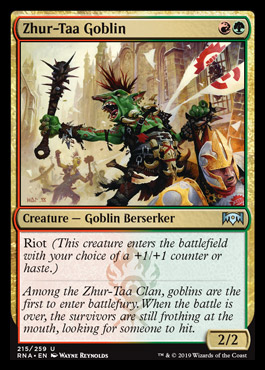
First of all, the name is fantastic. Riot! Attack! Smash face! It’s evocative, short, and memorable. That said, I’m not sure why “riot” means “get haste or get bigger.” Those are two useful options to have when rioting, I suppose, but the word suggests more chaos than planning. Still a great name, though.
The mechanic looks powerful and strategic. It’s a familiar spin on a couple genres of creature mechanics. On the one hand, it is a flexible mechanic that gives you two different creatures on a single card—like fabricate, evoke, or morph. But it’s also a combat modifier like exert, where you have to plan your damage output over multiple turns and choose your mode accordingly. Do you want a slower clock that starts a turn earlier? That’s not the only question posed by the Riot mechanic, but it’s a big one. I’m excited to see how the decisions work out in actual games.
Adapt
Simic mechanics always focus on +1/+1 counter shenanigans. Those tend to be fun and powerful while also lending themselves to all sorts of nonsense. Adapt continues this fine tradition, but it also riffs on one of my favorite Limited mechanics: Monstrosity. Nessian Asp is back, kinda.
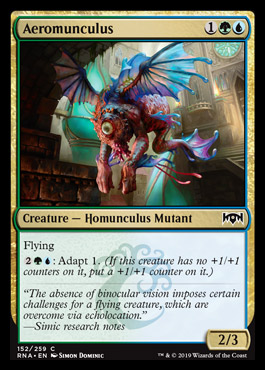
You have to work a bit harder to get the counters with Adapt than you did with Evolve or Graft. The mechanic seems more geared toward long games, and it looks like a better design than Monstrosity. That old mechanic from Theros gave your creature a one-time upgrade for an expensive mana investment. You could certainly play some games of Theros Limited where one or both players were making multiple creatures monstrous in epic back-and-forth battles. But usually the big upgrade was enough to end the game quickly. Adapt by contrast encourages you to mess around and harvest counters, like a Thallid or something. That has to mean some serious nonsense. Sign me up!
Afterlife
We’re all Doomed Travelers now. Is Afterlife a sly commentary on late-stage capitalism or democratic necrosis? Has the rot been quarantined within the Orzhov syndicate? Will a steady stream of spirit tokens oppress the Limited metagame? How did Abzan Ascendancy get repurposed for a non-ascendant guild?
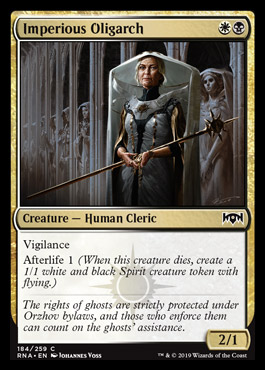
I don’t have good answers. Afterlife looks strong and frustrating to play against. I have a hard time seeing how Afterlife could be more broken in Limited than Extort, but it’s possible. That worries me. Creature recursion is very powerful, even when the second half is a “mere” 1/1 flying token. Hopefully there will be a bunch of spiders in the format to keep the bugs at bay.
Spectacle
I like the idea here—perhaps it points toward a grindier version of Rakdos? Spectacle feels a bit similar to Riot—both give you two versions of the same creature—but the Rakdos version feels messier to me and probably worse. I guess they can do whatever they want with Spectacle, from lowering the mana cost to providing a kicker-style bonus, or to who knows what. This new rare shows some promise, for example:
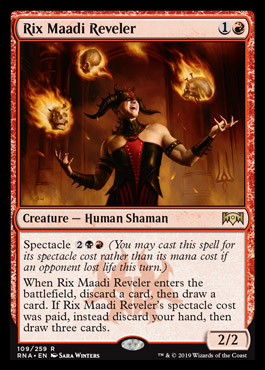
Spectacle should be exciting to me, but it isn’t. I think the life-loss condition makes it feel too much like Raid or Bloodthirst. If you are attacking every turn, all three mechanics are great. If you can’t make your opponent lose life, however, they do nothing. That really limits the strategies that your deck can employ: you have to be dealing damage consistently. Yes you generally want to do that, but there are other ways to win that you lose access to. Plus, your opponent will be trying to prevent your attacks regardless of their archetype or strategy. Meh.
Addendum
This one feels tacked on. By definition, the Addendum mechanic has to go on situational cards. Those tend not to be the cards you want to build a Limited deck around, which could lead to a weak guild in draft.
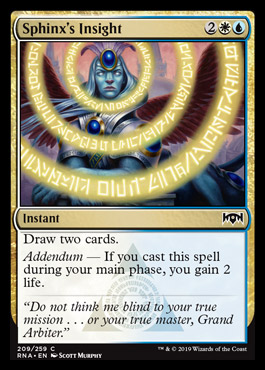
Yay? Look at my subtle decision trees! Which is better: holding up mana through your opponent’s turn, or gaining two life? Snooze. There’s also a rare “draw three” version of this card with a Scry 3 addendum. Fated Conflagration was a cool card, but this “mechanic” hardly felt worth the five-card cycle it got in Born of the Gods. How many situational effects can this work with? Not many, if the solution is to make non-situational effects like card draw Instants so that Addendum becomes a possibility. Bounce spells should be a perfect fit, and pump spells have some potential. After that it’s Timetwister, apparently.
Will Addendum show up on permanents with Flash? My guess is no. Is it bad form to give one unnecessary ability to enable adding another unnecessary ability? Would you care if Nephalia Seakite had Addendum to Scry 2? Addendum could be interesting on a card like Time of Ice, at least in theory. How much room do they have on the text boxes of these permanents, anyway?
Carrie O’Hara is Editor-in-Chief of Hipsters of the Coast.

